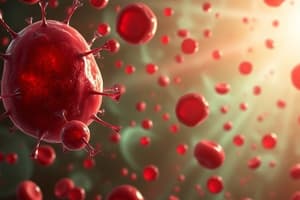Podcast
Questions and Answers
What is the primary function of blood in regulating the composition of interstitial fluid?
What is the primary function of blood in regulating the composition of interstitial fluid?
- Maintaining pH balance (correct)
- Delivering nutrients and hormones
- Removing waste products
- Transporting oxygen and carbon dioxide
Which of the following is NOT a function of blood?
Which of the following is NOT a function of blood?
- Defense against pathogens
- Production of hormones (correct)
- Heat regulation
- Transportation of metabolic wastes
What is the primary mechanism by which blood regulates the body's temperature?
What is the primary mechanism by which blood regulates the body's temperature?
- Moving heat away from the core to the skin
- Dilating blood vessels to release heat
- Constricting blood vessels to conserve heat
- All of the above (correct)
Which of the following is NOT a constituent of blood?
Which of the following is NOT a constituent of blood?
What is the process of blood cell formation called?
What is the process of blood cell formation called?
What is the main function of plasma proteins?
What is the main function of plasma proteins?
What is the primary role of red blood cells (erythrocytes)?
What is the primary role of red blood cells (erythrocytes)?
What is hematocrit?
What is hematocrit?
What is the role of fibrinogen in blood clotting?
What is the role of fibrinogen in blood clotting?
Which of these is NOT a function of blood?
Which of these is NOT a function of blood?
What is anemia?
What is anemia?
What is polycythemia?
What is polycythemia?
Which of these plasma proteins is responsible for iron transport?
Which of these plasma proteins is responsible for iron transport?
Flashcards
Functions of Blood
Functions of Blood
Blood transports gases, nutrients, hormones, and metabolic wastes.
Constituents of Blood
Constituents of Blood
Blood is composed of red blood cells, white blood cells, plasma, and platelets, each with specific functions.
Hematopoiesis
Hematopoiesis
The process of blood cell formation in the bone marrow.
Red Blood Cell Function
Red Blood Cell Function
Signup and view all the flashcards
Anemia Symptoms
Anemia Symptoms
Signup and view all the flashcards
Hematocrit
Hematocrit
Signup and view all the flashcards
Plasma Proteins
Plasma Proteins
Signup and view all the flashcards
Colloid Osmotic Pressure
Colloid Osmotic Pressure
Signup and view all the flashcards
Albumins
Albumins
Signup and view all the flashcards
Fibrinogen
Fibrinogen
Signup and view all the flashcards
Red Blood Cells (Erythrocytes)
Red Blood Cells (Erythrocytes)
Signup and view all the flashcards
Anemia
Anemia
Signup and view all the flashcards
Polycythemia
Polycythemia
Signup and view all the flashcards
Study Notes
Blood and Immune System - Intro and Red Blood Cells
- Blood Functions: Transports gases, nutrients, hormones, and metabolic wastes. Regulates interstitial fluid composition (pH, ions, water). Restricts fluid loss at injury sites (blood clotting). Defends against toxins and pathogens. Regulates body temperature.
- Blood Volume: 5 Liters in a 70 kg male, 4 liters in a 58 kg female.
- Blood Constituents: Plasma (46-63%) and formed elements (37-54%).
- Hematocrit: Percentage of total blood volume occupied by packed, centrifuged red blood cells. Normal values: 40-54% for males, 37-47% for females.
- Plasma Composition: Primarily water (92%). Contains amino acids, proteins (albumins, globulins, fibrinogen, transferrin), glucose, lipids, trace elements/vitamins, and gases (O2, CO2), and nitrogenous wastes. Most plasma proteins are produced by the liver.
Plasma Protein Functions
- General: Generate colloid osmotic pressure; buffer pH.
- Specific:
- Albumins: Maintain colloid osmotic pressure; carriers.
- Globulins (α and β): Clotting factors, enzymes, carriers. Globulins (γ): Antibodies
- Fibrinogen: Cleaved to form fibrin during blood clotting.
- Transferrin: Iron transport.
Formed Elements
- Erythrocytes (Red Blood Cells): 99.9% of cellular elements. Biconcave disk shape. Essentially bags filled with hemoglobin and enzymes for oxygen and carbon dioxide transport. ~5 million RBCs per microliter of blood.
- Leukocytes (White Blood Cells): 0.1% of cellular elements. Include lymphocytes, monocytes, neutrophils, eosinophils and basophils.
- Platelets: Fragments of cells involved in blood clotting.
- Differentiation count: Lymphocytes (20-40%), phagocytes (2-8%), granulocytes (50-70%).
Hematopoiesis
- Origin: In embryos, blood cells form in the yolk sac, liver, spleen and bone marrow. After birth, blood cell formation occurs in bone marrow.
- Location (adults): Bone marrow of pelvis, spine, ribs, cranium, and proximal ends of long bones.
- Process: Pluripotent hematopoietic stem cells differentiate into various progenitor cells, leading to the maturation of erythrocytes, leukocytes, and thrombocytes.
- Bone marrow composition: 25% erythrocytes, 75% leukocytes developing.
- Cytokine Regulation: Cytokines (e.g., erythropoietin, thrombopoietin, colony-stimulating factors) regulate hematopoiesis.
Red Blood Cell Structure and Function
- Structure: Biconcave discs, filled with hemoglobin and enzymes.
- Function: Transport oxygen and carbon dioxide.
- Hemoglobin: Contains iron, composed of globin (alpha and beta chains) and heme; contains oxygen molecules for transport to other body tissues. ~270 million molecules/ RBC.
Red Blood Cell Production
- Erythropoiesis: Erythropoietin (EPO) stimulates erythrocyte production in response to low oxygen levels.
- Requirements: Iron, vitamin B12 and folate are essential for this process.
Red Blood Cell Removal
- Life span: ~120 days.
- Mechanism: Old or damaged red blood cells are removed by macrophages in the spleen, liver, and bone marrow.
- Breakdown products: Hemoglobin is broken down, iron is conserved, heme is converted to bilirubin, and eliminated in bile (feces) and urine.
Anemia
- Definition: Reduced ability of blood to carry oxygen due to low red blood cell count/low hemoglobin.
- Symptoms: Tiredness, weakness, pale skin, headaches, dizziness.
- Causes:
- Low Production: Stem cell damage (aplastic), insufficient nutrients (iron, folate, B12), low erythropoietin.
- High Removal: Genetic defects in RBC proteins, parasitic infections, drug-induced, autoimmune reactions, and chronic bleeding (hemolytic or hemorrhagic).
Polycythemia
- Definition: Hematocrit is too high (typically >~54%).
- Symptoms: Increased blood viscosity, which can lead to reduced oxygen delivery to tissues.
- Causes: Abnormal erythrocyte precursors, low oxygen levels.
Studying That Suits You
Use AI to generate personalized quizzes and flashcards to suit your learning preferences.




